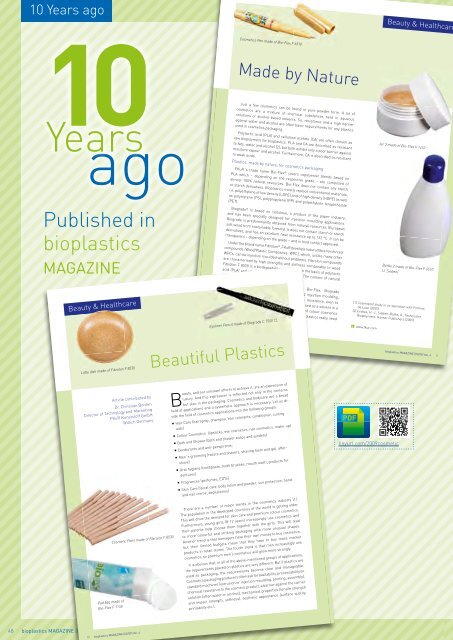Issue 02/2019
Highlights: Thermoforming Building & Construction Basics: Biobased Packaging
Highlights:
Thermoforming
Building & Construction
Basics: Biobased Packaging
You also want an ePaper? Increase the reach of your titles
YUMPU automatically turns print PDFs into web optimized ePapers that Google loves.
Plastics, made by nature, for cosmetics packaging<br />
10 Years ago<br />
10<br />
Years ago<br />
Cosmetics Pen made of Bio-Flex F 6510<br />
Beautiful Plastics Made by Nature<br />
Just a few cosmetics can be found in pure powder form. A lot of<br />
cosmetics are a mixture of chemical substances held in aqueous<br />
solutions or alcohol-based solvents. So, resistance and a high barrier<br />
against water and alcohol are often basic requirements for any plastics<br />
used in cosmetics packaging.<br />
Polylactic acid (PLA) and cellulose acetate (CA) are often chosen as<br />
raw biopolymers for bioplastics. PLA and CA are described as resistant<br />
to fats, water and alcohol [2], but both exhibit only a poor barrier against<br />
moisture vapour and alcohol. Furthermore, CA is described as resistant<br />
to weak acids.<br />
Beauty & Healthcare<br />
Jar 3 made of Bio-Flex V 1410<br />
Published in<br />
bioplastics<br />
MAGAZINE<br />
FKuR´s trade name Bio-Flex ® covers copolyester blends based on<br />
PLA which – depending on the respective grade – are composed of<br />
almost 100% natural resources. Bio-Flex does not contain any starch<br />
or starch derivatives. Bioplastics mostly replace conventional materials,<br />
i.e. polyethylene of low density (LDPE) and of high density (HDPE) as well<br />
as polystyrene (PS), polypropylene (PP) and polyethylene terephthalate<br />
(PET).<br />
Biograde ® is based on cellulose, a product of the paper industry,<br />
and has been specially designed for injection moulding applications.<br />
Biograde is predominantly obtained from natural resources (European<br />
soft wood from sustainable forestry). It does not contain starch or starch<br />
derivatives, and has an excellent heat resistance up to 122 °C. It can be<br />
transparent – depending on the grade – and is food contact approved.<br />
Under the brand name Fibrolon ® , FKuR develops natural fibre reinforced<br />
compounds (Wood/Plastic Composites: WPC), which, unlike many other<br />
WPCs, can be injection moulded without problems. Fibrolon compounds<br />
are characterised by high strengths and stiffness comparable to wood.<br />
Fibrolon F 8530 is a biodegradable compound on the basis of polylactic<br />
acid (PLA) and other compostable biopolymers. The content of natural<br />
resources is almost 100%.<br />
Bottle 2 made of Bio-Flex F 6510<br />
(J. Sieben)<br />
Beauty & Healthcare<br />
Little dish made of Fibrolon F 8530<br />
The applications described emphasise that Bio-Flex, Biograde<br />
and Fibrolon can be easily processed on standard injection moulding,<br />
blow moulding or extrusion machines. Biograde´s resistance, even to<br />
aggressive isododecane (a hydrocarbon ingredient used as a solvent in a<br />
number of cosmetic products) opens the wide field of colour cosmetics<br />
applications, however the barrier properties of all bioplastics really need<br />
to be improved.<br />
Eyeliner Pencil made of Biograde C 7500 CL<br />
[1] Cosmoprof study in co-operation with Formes<br />
de Luxe (2005)<br />
[2] Endres, H.-J., Siebert-Raths, A., Technische<br />
Biopolymere. Hanser Publishers (2009)<br />
www.fkur.com<br />
Beautiful Plastics Made by Nature<br />
bioplastics MAGAZINE [<strong>02</strong>/09] Vol. 4 11<br />
Article contributed by<br />
Dr. Christian Bonten<br />
Director of Technology and Marketing<br />
FKuR Kunststoff gmbH<br />
Willich germany<br />
Pad bag made of<br />
Bio-Flex F 1130<br />
Cosmetic Pens made of Fibrolon F 8530<br />
B<br />
eauty, and our constant efforts to achieve it, are an expression of<br />
luxury. And this expression is reflected not only in the contents<br />
but also in the packaging. Cosmetics and bodycare are a broad<br />
field of applications and a systematic approach is necessary. Let us divide<br />
the field of cosmetics applications into the following groups:<br />
• Hair Care (hairspray, shampoo, hair colorants, conditioner, curling<br />
aids)<br />
• Colour Cosmetics (lipsticks, eye cosmetics, nail cosmetics, make-up)<br />
• Bath and Shower (bath and shower soaps and syndets)<br />
• Deodorants and anti-perspirants,<br />
• Men´s grooming (razors and shavers, shaving foam and gel, aftershave)<br />
• Oral hygiene (toothpaste, tooth brushes, mouth wash, products for<br />
dentures)<br />
• Fragrances (perfumes, EDTs)<br />
• Skin Care (facial care, body lotion and powder, sun protection, hand<br />
and nail creme, depilatories)<br />
There are a number of major trends in the cosmetics industry [1].<br />
The population in the developed countries of the world is getting older.<br />
This will drive the demand for skin care and premium colour cosmetics.<br />
Furthermore, young girls (8-12 years) increasingly use cosmetics and<br />
their parents help choose them together with the girls. This will lead<br />
to more colourful and striking packaging with more unusual shapes.<br />
Another trend is that teenagers have their own money to buy cosmetics,<br />
but their limited budgets mean that they have to buy mass market<br />
products in retail stores. The fourth trend is that men increasingly use<br />
cosmetics, so premium men‘s cosmetics will grow more strongly.<br />
It is obvious that, in all of the above-mentioned groups of applications,<br />
the requirements placed on plastics are very different. But if plastics are<br />
used as packaging, the requirements become clear and manageable.<br />
Cosmetics packaging producers often ask for availability, processability on<br />
standard machines (extrusion or injection moulding, printing, assembly),<br />
chemical resistance to the cosmetic product, a barrier against the carrier<br />
solution (often water or alcohol), mechanical properties (tensile strength<br />
and impact strength, stiffness), aesthetic appearance (surface quality,<br />
printability etc.).<br />
tinyurl.com/2009cosmetic<br />
48 bioplastics MAGAZINE [<strong>02</strong>/19] Vol. 14<br />
10 bioplastics MAGAZINE [<strong>02</strong>/09] Vol. 4


















